
|

|
Ev ve Ofis taşıma sektöründe lider olmak.Teknolojiyi klrd takip ederek bunu müşteri menuniyeti amacı için kullanmak.Sektörde marka olmak.
İstanbul evden eve nakliyat
Misyonumuz sayesinde edindiğimiz müşteri memnuniyeti ve güven ile müşterilerimizin bizi tavsiye etmelerini sağlamak.
3D Ear Biometrics
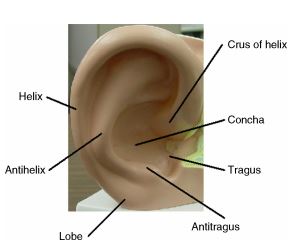 The human ear is a new class of relatively stable
biometrics. After decades of research of anthropometric
measurements of ear photographs of thousands of
people, it has been found that no two ears are alike, even
in the cases of identical and fraternal twins, triplets, and
quadruplets. It is also found that the structure of
the ear does not change radically over time. Ear biometric
has played a significant role in forensic science
and its use by law enforcement agencies for many years
but most of this work has been on analyzing the ear
prints manually. Recent work on ear biometrics focuses
on developing automated techniques for ear recognition.
Ear biometrics can be based on a 2D gray scale
or color image, 3D range image, or a combination of
2D and 3D images. Typically, an ear biometric system
consists of ear detection and ear recognition modules.
The human ear is a new class of relatively stable
biometrics. After decades of research of anthropometric
measurements of ear photographs of thousands of
people, it has been found that no two ears are alike, even
in the cases of identical and fraternal twins, triplets, and
quadruplets. It is also found that the structure of
the ear does not change radically over time. Ear biometric
has played a significant role in forensic science
and its use by law enforcement agencies for many years
but most of this work has been on analyzing the ear
prints manually. Recent work on ear biometrics focuses
on developing automated techniques for ear recognition.
Ear biometrics can be based on a 2D gray scale
or color image, 3D range image, or a combination of
2D and 3D images. Typically, an ear biometric system
consists of ear detection and ear recognition modules.
Efficient Recognition of Highly Similar 3D Objects in Range Images
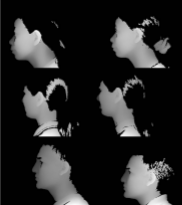 For rapid indexing and recognition of highly similar objects, we
propose a novel method which combines feature embedding for the fast retrieval of surface descriptors,
novel similarity measures for correspondence, and a support vector machine-based learning technique for
ranking the hypotheses. By searching the nearest neighbors
in low dimensions, the similarity between a model-test pair is computed using the novel features. The
similarities for all model-test pairs are ranked using the learning algorithm to generate a short-list of candidate
models for verification. The verification is performed by aligning a model with the test object. The experimental
results, on the University of Notre Dame data set (302 subjects with 604 images) and the University of
California at Riverside data set (155 subjects with 902 images) which contain 3D human ears, are presented
and compared with the geometric hashing technique to demonstrate the efficiency and effectiveness of the
proposed approach.
For rapid indexing and recognition of highly similar objects, we
propose a novel method which combines feature embedding for the fast retrieval of surface descriptors,
novel similarity measures for correspondence, and a support vector machine-based learning technique for
ranking the hypotheses. By searching the nearest neighbors
in low dimensions, the similarity between a model-test pair is computed using the novel features. The
similarities for all model-test pairs are ranked using the learning algorithm to generate a short-list of candidate
models for verification. The verification is performed by aligning a model with the test object. The experimental
results, on the University of Notre Dame data set (302 subjects with 604 images) and the University of
California at Riverside data set (155 subjects with 902 images) which contain 3D human ears, are presented
and compared with the geometric hashing technique to demonstrate the efficiency and effectiveness of the
proposed approach.
Human Recognition at a Distance
.png) This paper consider face, side face, gait and ear and their possible fusion for human recognition. It presents an overview of some of the techniques that we have developed for (a) super-resoulution-based face recognition in video, (b) gait-based recognition in video, (c) fusion of super-resolved side face and gait in video, (d) ear recognition in color/range images, and (e) fusion performance prediction and validation. It presents various real-world examples to illustrate the ideas and points out the relative merits of the approaches that are discussed.
This paper consider face, side face, gait and ear and their possible fusion for human recognition. It presents an overview of some of the techniques that we have developed for (a) super-resoulution-based face recognition in video, (b) gait-based recognition in video, (c) fusion of super-resolved side face and gait in video, (d) ear recognition in color/range images, and (e) fusion performance prediction and validation. It presents various real-world examples to illustrate the ideas and points out the relative merits of the approaches that are discussed.
3D Free-form Object Recognition in Range Images using Local Surface Patches
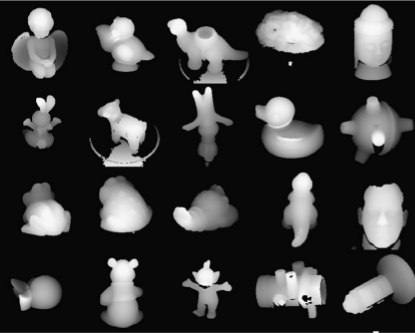 Here we introduce an integrated local surface descriptor for surface representation and 3D object
recognition. A local surface descriptor is characterized by its centroid, its local surface type and a 2D
histogram. The 2D histogram shows the frequency of occurrence of shape index values vs. the angles
between the normal of reference feature point and that of its neighbors. Instead of calculating local surface
descriptors for all the 3D surface points, they are calculated only for feature points that are in areas with
large shape variation.
Experimental results with real range data are presented to demonstrate and compare the effectiveness and
efficiency of the proposed approach with the spin image and the spherical spin image representations.
Here we introduce an integrated local surface descriptor for surface representation and 3D object
recognition. A local surface descriptor is characterized by its centroid, its local surface type and a 2D
histogram. The 2D histogram shows the frequency of occurrence of shape index values vs. the angles
between the normal of reference feature point and that of its neighbors. Instead of calculating local surface
descriptors for all the 3D surface points, they are calculated only for feature points that are in areas with
large shape variation.
Experimental results with real range data are presented to demonstrate and compare the effectiveness and
efficiency of the proposed approach with the spin image and the spherical spin image representations.
Human Ear Recognition in 3D
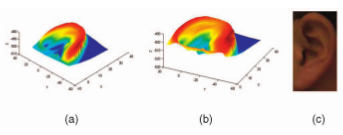 The human ear is a new class of relatively stable biometrics that has drawn researchers’ attention.
We proposed a human recognition system using 3D ear biometrics. For ear detection, we proposed a new
approach which uses a single reference 3D ear shape model and locates the ear helix and the antihelix.
For ear identification and verification, two new representations are proposed. These include the ear
helix/antihelix representation obtained from the detection algorithm and the local surface patch (LSP)
representation.
The human ear is a new class of relatively stable biometrics that has drawn researchers’ attention.
We proposed a human recognition system using 3D ear biometrics. For ear detection, we proposed a new
approach which uses a single reference 3D ear shape model and locates the ear helix and the antihelix.
For ear identification and verification, two new representations are proposed. These include the ear
helix/antihelix representation obtained from the detection algorithm and the local surface patch (LSP)
representation.
Human Ear Detection from Side Face Range Images
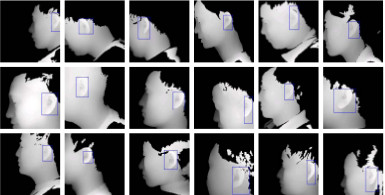 Ear detection is an important part of an ear recognition
system. We have addressed human ear detection from
side face range images. We introduce a simple and effective
method to detect ears, which has two stages: offline
model template building and on-line detection. The model
template is represented by an averaged histogram of shape
index. The on-line detection is a four-step process: step
edge detection and thresholding, image dilation, connectcomponent
labeling and template matching. Experiment results
with real ear images are presented to demonstrate the
effectiveness of our approach.
Ear detection is an important part of an ear recognition
system. We have addressed human ear detection from
side face range images. We introduce a simple and effective
method to detect ears, which has two stages: offline
model template building and on-line detection. The model
template is represented by an averaged histogram of shape
index. The on-line detection is a four-step process: step
edge detection and thresholding, image dilation, connectcomponent
labeling and template matching. Experiment results
with real ear images are presented to demonstrate the
effectiveness of our approach.
Global-to-Local Non-Rigid Shape Registration
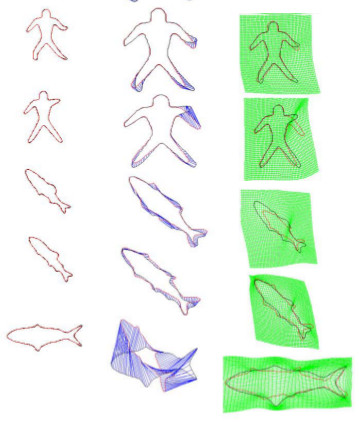 Non-rigid shape registration is an important issue in
computer vision. In this paper we propose a novel global-to-
local procedure for aligning non-rigid shapes. The
global similarity transformation is obtained based on the
corresponding pairs found by matching shape context descriptors.
The local deformation is performed within an
optimization formulation, in which the bending energy of
thin plate spline transformation is incorporated as a regularization
term to keep the structure of the model shape
preserved under the shape deformation. The optimization
procedure drives the initial global registration towards the
target shape that results in the one-to-one correspondence
between the model and target shape. Experimental results
demonstrate the effectiveness of the proposed approach.
Non-rigid shape registration is an important issue in
computer vision. In this paper we propose a novel global-to-
local procedure for aligning non-rigid shapes. The
global similarity transformation is obtained based on the
corresponding pairs found by matching shape context descriptors.
The local deformation is performed within an
optimization formulation, in which the bending energy of
thin plate spline transformation is incorporated as a regularization
term to keep the structure of the model shape
preserved under the shape deformation. The optimization
procedure drives the initial global registration towards the
target shape that results in the one-to-one correspondence
between the model and target shape. Experimental results
demonstrate the effectiveness of the proposed approach.
Performance evaluation and prediction for 3-D ear recognition
.png) Existing ear recognition approaches do not give theoretical or experimental performance prediction. Therefore, the discriminating power of ear biometric for human identification cannot be evaluated. This paper addresses two interrelated problems: (a) proposes an integrated local descriptor for representation to recognize human ears in 3D. Comparing local surface descriptors between a test and a model image, an initial correspondence of local surface patches is established and then filtered using simple geometric constraints. The performance of the proposed ear recognition system is evaluated on a real range image database of 52 subjects. (b) A binomial model is also presented to predict the ear recognition performance. Match and non-matched distances obtained from the database of 52 subjects are used to estimate the distributions. By modeling cumulative match characteristic (CMC) curve as a binomial distribution, the ear recognition performance can be predicted on a larger gallery.
Existing ear recognition approaches do not give theoretical or experimental performance prediction. Therefore, the discriminating power of ear biometric for human identification cannot be evaluated. This paper addresses two interrelated problems: (a) proposes an integrated local descriptor for representation to recognize human ears in 3D. Comparing local surface descriptors between a test and a model image, an initial correspondence of local surface patches is established and then filtered using simple geometric constraints. The performance of the proposed ear recognition system is evaluated on a real range image database of 52 subjects. (b) A binomial model is also presented to predict the ear recognition performance. Match and non-matched distances obtained from the database of 52 subjects are used to estimate the distributions. By modeling cumulative match characteristic (CMC) curve as a binomial distribution, the ear recognition performance can be predicted on a larger gallery.
Contour Matching for 3D Ear Recognition
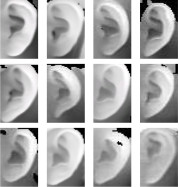 Ear is a new class of relatively stable biometric that is
invariant from childhood to early old age (8 to 70). It is not
affected with facial expressions, cosmetics and eye glasses.
We introduce a two-step ICP (Iterative Closest
Point) algorithm for matching 3D ears. In the first step,
the helix of the ear in 3D images is detected. The ICP algorithm
is run to find the initial rigid transformation to align
a model ear helix with the test ear helix. In the second step,
the initial transformation is applied to selected locations
of model ears and the ICP algorithm iteratively refines the
transformation to bring model ears and test ear into best
alignment. The root mean square (RMS) registration error
is used as the matching error criterion. The model ear with
the minimum RMS error is declared as the recognized ear.
Experimental results on a dataset of 30 subjects with 3D ear
images are presented to demonstrate the effectiveness of the
approach.
Ear is a new class of relatively stable biometric that is
invariant from childhood to early old age (8 to 70). It is not
affected with facial expressions, cosmetics and eye glasses.
We introduce a two-step ICP (Iterative Closest
Point) algorithm for matching 3D ears. In the first step,
the helix of the ear in 3D images is detected. The ICP algorithm
is run to find the initial rigid transformation to align
a model ear helix with the test ear helix. In the second step,
the initial transformation is applied to selected locations
of model ears and the ICP algorithm iteratively refines the
transformation to bring model ears and test ear into best
alignment. The root mean square (RMS) registration error
is used as the matching error criterion. The model ear with
the minimum RMS error is declared as the recognized ear.
Experimental results on a dataset of 30 subjects with 3D ear
images are presented to demonstrate the effectiveness of the
approach.
Shape Model-Based 3D Ear Detection from Side Face Range Images
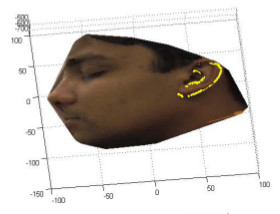 Ear detection is an important part of an ear recognition
system. We propose a shape model-based
technique for locating human ears in side face range images.
The ear shape model is represented by a set of discrete
3D vertices corresponding to ear helix and anti-helix parts.
Given side face range images, step edges are extracted considering
the fact that there are strong step edges around the
ear helix part. Then the edge segments are dilated, thinned
and grouped into different clusters which are potential regions
containing ears. For each cluster, we register the ear
shape model with the edges. The region with the minimum
mean registration error is declared as the detected ear region;
the ear helix and anti-helix parts are meanwhile identified.
Experiments are performed with a large number of
real face range images to demonstrate the effectiveness of
our approach. The contributions of this research are: (a) a
ear shape model for locating 3D ears in side face range images,
(b) an effective approach to detect human ears from
side face range images, (c) experimental results on a large
number of ear images.
Ear detection is an important part of an ear recognition
system. We propose a shape model-based
technique for locating human ears in side face range images.
The ear shape model is represented by a set of discrete
3D vertices corresponding to ear helix and anti-helix parts.
Given side face range images, step edges are extracted considering
the fact that there are strong step edges around the
ear helix part. Then the edge segments are dilated, thinned
and grouped into different clusters which are potential regions
containing ears. For each cluster, we register the ear
shape model with the edges. The region with the minimum
mean registration error is declared as the detected ear region;
the ear helix and anti-helix parts are meanwhile identified.
Experiments are performed with a large number of
real face range images to demonstrate the effectiveness of
our approach. The contributions of this research are: (a) a
ear shape model for locating 3D ears in side face range images,
(b) an effective approach to detect human ears from
side face range images, (c) experimental results on a large
number of ear images.
Human Ear Recognition from Side Face Range Images
.png) Ear detection is an important part of an ear recognition system. In this paper we address human ear detection from side face range images. We introduce a simple and effective method to detect ears, which has two stages: offline model template building and on-line detection. The model template is represented by an averaged histogram of shape index. The on-line detection is a four-step process: step edge detection and thresholding, image dilation, connectcomponent labeling and template matching. Experiment results with real ear images are presented to demonstrate the effectiveness of our approach.
Ear detection is an important part of an ear recognition system. In this paper we address human ear detection from side face range images. We introduce a simple and effective method to detect ears, which has two stages: offline model template building and on-line detection. The model template is represented by an averaged histogram of shape index. The on-line detection is a four-step process: step edge detection and thresholding, image dilation, connectcomponent labeling and template matching. Experiment results with real ear images are presented to demonstrate the effectiveness of our approach.
|
|
Top Bangladeshi Online Casinos of 2024: Step Up Your Game
With 2024 underway, now is the perfect time to explore the best online casinos in Bangladesh. Elevate your gaming experience with these top platforms.
Benefits of Playing on JEETBUZZ and MCW: The Best Casino Sites in Bangladesh
There are many advantages to choosing trusted online casino sites in Bangladesh like JEETBUZZ and MCW. In this article, we will discuss some of the benefits these sites offer, known for their big wins and top-notch customer service. If you're new to online casinos, you should be aware of the various types of games offered by these platforms. Use our reviews to decide which site best meets your needs. Remember, both JEETBUZZ and MCW offer a range of perks that will make your gaming experience more enjoyable and profitable.
Baji999: Your Ticket to Mega Jackpots
Baji999 is the place where dreams turn into reality with massive payouts and thrilling games. Don’t wait—unlock your potential with Baji999 this year.
1xBet: Where Winning Knows No Limits
JeetWin offers a gaming experience like no other. With exciting games and lucrative promotions, 1xBet is the casino to watch in 2024.
Crickex: Your Reliable Partner in Winning
Join Crickex in 2024 for a secure, rewarding gaming journey. Consistent wins and top-tier service make Crickex a must-visit for any serious player.
Crickex Login: Your Gateway to Non-Stop Gaming
Seamlessly access all your favorite games with Crickex Login. Don't let anything stop your winning momentum in 2024.
Crickex Live: Thrills and Wins in Real-Time
Experience the excitement of live gaming with Crickex Live. Bet live and enjoy the excitement in real-time throughout 2024.
Baji Live: Unleash the Thrills of Live Gaming
With Baji Live, you get the best of live casino gaming. Dive into real-time action and win big in 2024.
MCW: Innovating the Online Casino Scene
MCW is pushing the boundaries of online casinos in 2024. MCW offers a variety of games and promotions that keep you coming back for more.
Babu88: Consistent Wins, Every Time
Enjoy user-friendly interfaces and high-payout games at Babu88. Start your winning journey with Babu88 in 2024.
Bet365: Bet on Success
From sports betting to casino games, Bet365 has it all. Join Bet365 for a comprehensive betting experience in 2024.
MCW: Elevate Your Casino Experience Fatatati
Join MCW and discover innovative Fatati gaming opportunities in 2024.


 For rapid indexing and recognition of highly similar objects, we
propose a novel method which combines feature embedding for the fast retrieval of surface descriptors,
novel similarity measures for correspondence, and a support vector machine-based learning technique for
ranking the hypotheses. By searching the nearest neighbors
in low dimensions, the similarity between a model-test pair is computed using the novel features. The
similarities for all model-test pairs are ranked using the learning algorithm to generate a short-list of candidate
models for verification. The verification is performed by aligning a model with the test object. The experimental
results, on the University of Notre Dame data set (302 subjects with 604 images) and the University of
California at Riverside data set (155 subjects with 902 images) which contain 3D human ears, are presented
and compared with the geometric hashing technique to demonstrate the efficiency and effectiveness of the
proposed approach.
For rapid indexing and recognition of highly similar objects, we
propose a novel method which combines feature embedding for the fast retrieval of surface descriptors,
novel similarity measures for correspondence, and a support vector machine-based learning technique for
ranking the hypotheses. By searching the nearest neighbors
in low dimensions, the similarity between a model-test pair is computed using the novel features. The
similarities for all model-test pairs are ranked using the learning algorithm to generate a short-list of candidate
models for verification. The verification is performed by aligning a model with the test object. The experimental
results, on the University of Notre Dame data set (302 subjects with 604 images) and the University of
California at Riverside data set (155 subjects with 902 images) which contain 3D human ears, are presented
and compared with the geometric hashing technique to demonstrate the efficiency and effectiveness of the
proposed approach.
.png) This paper consider face, side face, gait and ear and their possible fusion for human recognition. It presents an overview of some of the techniques that we have developed for (a) super-resoulution-based face recognition in video, (b) gait-based recognition in video, (c) fusion of super-resolved side face and gait in video, (d) ear recognition in color/range images, and (e) fusion performance prediction and validation. It presents various real-world examples to illustrate the ideas and points out the relative merits of the approaches that are discussed.
This paper consider face, side face, gait and ear and their possible fusion for human recognition. It presents an overview of some of the techniques that we have developed for (a) super-resoulution-based face recognition in video, (b) gait-based recognition in video, (c) fusion of super-resolved side face and gait in video, (d) ear recognition in color/range images, and (e) fusion performance prediction and validation. It presents various real-world examples to illustrate the ideas and points out the relative merits of the approaches that are discussed.
 Here we introduce an integrated local surface descriptor for surface representation and 3D object
recognition. A local surface descriptor is characterized by its centroid, its local surface type and a 2D
histogram. The 2D histogram shows the frequency of occurrence of shape index values vs. the angles
between the normal of reference feature point and that of its neighbors. Instead of calculating local surface
descriptors for all the 3D surface points, they are calculated only for feature points that are in areas with
large shape variation.
Experimental results with real range data are presented to demonstrate and compare the effectiveness and
efficiency of the proposed approach with the spin image and the spherical spin image representations.
Here we introduce an integrated local surface descriptor for surface representation and 3D object
recognition. A local surface descriptor is characterized by its centroid, its local surface type and a 2D
histogram. The 2D histogram shows the frequency of occurrence of shape index values vs. the angles
between the normal of reference feature point and that of its neighbors. Instead of calculating local surface
descriptors for all the 3D surface points, they are calculated only for feature points that are in areas with
large shape variation.
Experimental results with real range data are presented to demonstrate and compare the effectiveness and
efficiency of the proposed approach with the spin image and the spherical spin image representations.
 The human ear is a new class of relatively stable biometrics that has drawn researchers’ attention.
We proposed a human recognition system using 3D ear biometrics. For ear detection, we proposed a new
approach which uses a single reference 3D ear shape model and locates the ear helix and the antihelix.
For ear identification and verification, two new representations are proposed. These include the ear
helix/antihelix representation obtained from the detection algorithm and the local surface patch (LSP)
representation.
The human ear is a new class of relatively stable biometrics that has drawn researchers’ attention.
We proposed a human recognition system using 3D ear biometrics. For ear detection, we proposed a new
approach which uses a single reference 3D ear shape model and locates the ear helix and the antihelix.
For ear identification and verification, two new representations are proposed. These include the ear
helix/antihelix representation obtained from the detection algorithm and the local surface patch (LSP)
representation.
 Ear detection is an important part of an ear recognition
system. We have addressed human ear detection from
side face range images. We introduce a simple and effective
method to detect ears, which has two stages: offline
model template building and on-line detection. The model
template is represented by an averaged histogram of shape
index. The on-line detection is a four-step process: step
edge detection and thresholding, image dilation, connectcomponent
labeling and template matching. Experiment results
with real ear images are presented to demonstrate the
effectiveness of our approach.
Ear detection is an important part of an ear recognition
system. We have addressed human ear detection from
side face range images. We introduce a simple and effective
method to detect ears, which has two stages: offline
model template building and on-line detection. The model
template is represented by an averaged histogram of shape
index. The on-line detection is a four-step process: step
edge detection and thresholding, image dilation, connectcomponent
labeling and template matching. Experiment results
with real ear images are presented to demonstrate the
effectiveness of our approach.
 Non-rigid shape registration is an important issue in
computer vision. In this paper we propose a novel global-to-
local procedure for aligning non-rigid shapes. The
global similarity transformation is obtained based on the
corresponding pairs found by matching shape context descriptors.
The local deformation is performed within an
optimization formulation, in which the bending energy of
thin plate spline transformation is incorporated as a regularization
term to keep the structure of the model shape
preserved under the shape deformation. The optimization
procedure drives the initial global registration towards the
target shape that results in the one-to-one correspondence
between the model and target shape. Experimental results
demonstrate the effectiveness of the proposed approach.
Non-rigid shape registration is an important issue in
computer vision. In this paper we propose a novel global-to-
local procedure for aligning non-rigid shapes. The
global similarity transformation is obtained based on the
corresponding pairs found by matching shape context descriptors.
The local deformation is performed within an
optimization formulation, in which the bending energy of
thin plate spline transformation is incorporated as a regularization
term to keep the structure of the model shape
preserved under the shape deformation. The optimization
procedure drives the initial global registration towards the
target shape that results in the one-to-one correspondence
between the model and target shape. Experimental results
demonstrate the effectiveness of the proposed approach.
.png) Existing ear recognition approaches do not give theoretical or experimental performance prediction. Therefore, the discriminating power of ear biometric for human identification cannot be evaluated. This paper addresses two interrelated problems: (a) proposes an integrated local descriptor for representation to recognize human ears in 3D. Comparing local surface descriptors between a test and a model image, an initial correspondence of local surface patches is established and then filtered using simple geometric constraints. The performance of the proposed ear recognition system is evaluated on a real range image database of 52 subjects. (b) A binomial model is also presented to predict the ear recognition performance. Match and non-matched distances obtained from the database of 52 subjects are used to estimate the distributions. By modeling cumulative match characteristic (CMC) curve as a binomial distribution, the ear recognition performance can be predicted on a larger gallery.
Existing ear recognition approaches do not give theoretical or experimental performance prediction. Therefore, the discriminating power of ear biometric for human identification cannot be evaluated. This paper addresses two interrelated problems: (a) proposes an integrated local descriptor for representation to recognize human ears in 3D. Comparing local surface descriptors between a test and a model image, an initial correspondence of local surface patches is established and then filtered using simple geometric constraints. The performance of the proposed ear recognition system is evaluated on a real range image database of 52 subjects. (b) A binomial model is also presented to predict the ear recognition performance. Match and non-matched distances obtained from the database of 52 subjects are used to estimate the distributions. By modeling cumulative match characteristic (CMC) curve as a binomial distribution, the ear recognition performance can be predicted on a larger gallery.
 Ear is a new class of relatively stable biometric that is
invariant from childhood to early old age (8 to 70). It is not
affected with facial expressions, cosmetics and eye glasses.
We introduce a two-step ICP (Iterative Closest
Point) algorithm for matching 3D ears. In the first step,
the helix of the ear in 3D images is detected. The ICP algorithm
is run to find the initial rigid transformation to align
a model ear helix with the test ear helix. In the second step,
the initial transformation is applied to selected locations
of model ears and the ICP algorithm iteratively refines the
transformation to bring model ears and test ear into best
alignment. The root mean square (RMS) registration error
is used as the matching error criterion. The model ear with
the minimum RMS error is declared as the recognized ear.
Experimental results on a dataset of 30 subjects with 3D ear
images are presented to demonstrate the effectiveness of the
approach.
Ear is a new class of relatively stable biometric that is
invariant from childhood to early old age (8 to 70). It is not
affected with facial expressions, cosmetics and eye glasses.
We introduce a two-step ICP (Iterative Closest
Point) algorithm for matching 3D ears. In the first step,
the helix of the ear in 3D images is detected. The ICP algorithm
is run to find the initial rigid transformation to align
a model ear helix with the test ear helix. In the second step,
the initial transformation is applied to selected locations
of model ears and the ICP algorithm iteratively refines the
transformation to bring model ears and test ear into best
alignment. The root mean square (RMS) registration error
is used as the matching error criterion. The model ear with
the minimum RMS error is declared as the recognized ear.
Experimental results on a dataset of 30 subjects with 3D ear
images are presented to demonstrate the effectiveness of the
approach.
 Ear detection is an important part of an ear recognition
system. We propose a shape model-based
technique for locating human ears in side face range images.
The ear shape model is represented by a set of discrete
3D vertices corresponding to ear helix and anti-helix parts.
Given side face range images, step edges are extracted considering
the fact that there are strong step edges around the
ear helix part. Then the edge segments are dilated, thinned
and grouped into different clusters which are potential regions
containing ears. For each cluster, we register the ear
shape model with the edges. The region with the minimum
mean registration error is declared as the detected ear region;
the ear helix and anti-helix parts are meanwhile identified.
Experiments are performed with a large number of
real face range images to demonstrate the effectiveness of
our approach. The contributions of this research are: (a) a
ear shape model for locating 3D ears in side face range images,
(b) an effective approach to detect human ears from
side face range images, (c) experimental results on a large
number of ear images.
Ear detection is an important part of an ear recognition
system. We propose a shape model-based
technique for locating human ears in side face range images.
The ear shape model is represented by a set of discrete
3D vertices corresponding to ear helix and anti-helix parts.
Given side face range images, step edges are extracted considering
the fact that there are strong step edges around the
ear helix part. Then the edge segments are dilated, thinned
and grouped into different clusters which are potential regions
containing ears. For each cluster, we register the ear
shape model with the edges. The region with the minimum
mean registration error is declared as the detected ear region;
the ear helix and anti-helix parts are meanwhile identified.
Experiments are performed with a large number of
real face range images to demonstrate the effectiveness of
our approach. The contributions of this research are: (a) a
ear shape model for locating 3D ears in side face range images,
(b) an effective approach to detect human ears from
side face range images, (c) experimental results on a large
number of ear images.
.png) Ear detection is an important part of an ear recognition system. In this paper we address human ear detection from side face range images. We introduce a simple and effective method to detect ears, which has two stages: offline model template building and on-line detection. The model template is represented by an averaged histogram of shape index. The on-line detection is a four-step process: step edge detection and thresholding, image dilation, connectcomponent labeling and template matching. Experiment results with real ear images are presented to demonstrate the effectiveness of our approach.
Ear detection is an important part of an ear recognition system. In this paper we address human ear detection from side face range images. We introduce a simple and effective method to detect ears, which has two stages: offline model template building and on-line detection. The model template is represented by an averaged histogram of shape index. The on-line detection is a four-step process: step edge detection and thresholding, image dilation, connectcomponent labeling and template matching. Experiment results with real ear images are presented to demonstrate the effectiveness of our approach.